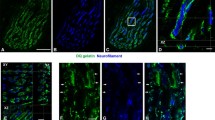Abstract
A time course study was conducted to investigate the possibility of a relationship between fiber degeneration and glycogen depletion in chronically nerve-stimulated extensor digitorum longus muscle of the rabbit. Muscles were stimulated 12 h daily at 10 Hz using alternating one-hour periods of stimulation and rest. When measured for the first time after 3 h (1 h stimulation, 1 h rest, 1 h stimulation), microphotometry revealed complete glycogen depletion of all fiber types (fast glycolytic, FG; fast oxidative glycolytic, FOG; slow oxidative, SO). Different responses were noted beginning at day 4. At this time point, all FOG and SO fibers recovered their glycogen stores with some of the FOG population attaining levels higher than the FOG fibers in the unstimulated, contralateral muscle. Approximately 28% of the FG fibers recovered to normal glycogen values, whereas 58% remained depleted and 14% displayed “overshoting glycogen” levels. Fifteen percent of all fibers were glycogen-depleted after 12 days of stimulation. At this time, classic fiber types could no longer be distinguished. Fiber degeneration, which was recognized by the invasion of nonmuscle cells, began after 6 days and was restricted to the glycogen-depleted fibers. By this time, there was also a significant increase in DNA content. Exhaustions of glycogen, the main fuel of the FG fibers, is believed to cause a collapse of energy-supply and ATP-driven ionic pumps. The latter could be the initial step of fiber deterioration.
Similar content being viewed by others
References
Armstrong RB, Laughlin MH (1985) Rat muscle blood flows during high-speed locomotion. J Appl Physiol 59:1322–1328
Brooke MH, Kaiser KK (1970) Three “myosin adenosine triphosphatase” systems: the nature of their pH lability and sulfhydryl dependence. J Histochem Cytochem 18:670–672
Burke RE, Levine DN, Tsairis P, Zajac III FE (1973) Physiological types and histochemical profiles in motor units of the cat gastronemius. J Physiol (Lond) 234:723–748
Eisenberg BR, Brown JMC, Salmons S (1984) Restoration of fast muscle characteristics following cessation of chronic stimulation. The ultrastructure of slow-to-fast transformation. Cell Tissue Res 238:221–230
Gutmann E (1962) The denervated muscle. Publishing House of the Czechoslovak Academy of Sciences
Halkjaer-Kristensen J, Ingemann-Hansen T (1979) Microphotometric determination of glycogen in single fibers of human quadriceps muscle. Histochem J 11:629–638
Helmreich E, Danforth WH, Karpatkin S, Cori CF (1965) The response of the glycolytic system of anaerobic frog sartorius muscle to electrical stimulation. In: Chance B, Estabrook RW, Williamson JR (eds) Control of energy metabolism. Academic Press, New York London, pp 299–312
Hennig R, Lømo T (1985) Firing patterns of motor units in normal rats. Nature (Lond) 314:164–166
Hinegardner RT (1971) An improved fluorometric assay for DNA. Anal Biochem 39:197–201
Hintz CS, Chi M M-Y, Fell RD, Ivy JL, Kaiser KK, Lowry Ch V, Lowry OH (1982) Metabolite changes in individual rat muscle fibers during stimulation. Am J Physiol 242:C218–C228
Hintz CS, Chi M M-Y, Lowry OH (1984) Heterogeneity in regard to enzymes and metabolites within individual muscle fibres. Am J Physiol 246:C288–C292
Holloszy JO, Narahara HT (1965) Studies of tissue permeability. X. Changes in permeability to 3-methylglucose associated with contraction of isolated frog muscle. J Biol Chem 240:3493–3500
Hudlická O (1985) Regulation of muscle blood flow. Clin Physiol 5:201–229
Hudlická O, Brown M, Cotter M, Smith M, Vrbová G (1977) The effect of long-term stimulation of fast muscles on their blood flow, metabolism and ability to withstand fatigue. Pflügers Arch 369:141–149
Jennische E (1985) Ischaemia-induced injury in glycogen-depleted skeketal muscle. Selective vulnerability of FG-fibres. Acta Physiol Scand 125:727–734
Jolesz F, Sréter FA (1981) Development, innervation, and activity-pattern induced changes in skeletal muscle. Annu Rev Physiol 43:531–552
Maier A, Gambke B, Pette D (1986) Degeneration-regeneration as a mechanism contributing to the fast to slow conversion of chronically stimulated fast-twitch rabbit muscle. Cell Tissue Res 244:635–643
McCully KK, Faulkner JA (1985) Injury to skeletal muscle fibers of mice following lengthening contractions. J Appl Physiol 59:119–126
Peter JB, Barnard RJ, Edgerton VR, Gillespie CA, Stempel KE (1972) Metabolic profiles of three fibertypes of skeletal muscle in guinea pigs and rabbits. Biochemistry 11:2627–2633
Pette D (1984) Activity-induced fast to slow transitions in mammalian muscle. Med Sci Sports Exerc 16:517–528
Pette D (1986) Regulation of phenotype expression in skeletal muscle fibers by increased contractile activity. In: Saltin B (ed) Biochemistry of exercise. Human Kinetics Publishers Inc, Champaign, IL, pp 3–26
Pette D, Spamer C (1986) Metabolic properties of muscle fibers. Fed Proc 45:2910–2914
Pette D, Smith ME, Staudte HW, Vrbová G (1973) Effects of longterm electrical stimulation on some contractile and metabolic characteristics of fast rabbit muscles. Pflügers Arch 338:257–272
Pette D, Wasmund H, Wimmer M (1979) Principle and method of kinetic microphotometric enzyme activity determination in situ. Histochemistry 65:1–10
Reichmann H, Pette D (1982) A comparative microphotometric study of succinate dehydrogenase activity levels in type I. IIA and IIB fibres of mammalian and human muscles. Histochemistry 74:27–41
Reichmann H, Hoppeler H, Mathieu-Costello O, von Bergen F, Pette D (1985) Biochemical and ultrastructural changes of skeletal muscle mitochondrial after chronic electrical stimulation in rabbits. Pflügers Arch 404:1–9
Salmons S, Henriksson J (1981) The adaptive response of skeletal muscle to increased use. Muscle Nerve 4:94–105
Salmons S, Vrbová G (1969) The influence of activity on some contractile characteristics of mammalian fast and slow muscles. J Physiol (Lond) 201:535–549
Schwarz G, Leisner E, Pette D (1983) Two telestimulation systems for chronic indirect muscle stimulation in caged rabbits and mice. Pflügers Arch 398:130–133
Sréter FA, Pinter K, Jolesz F, Mabuchi K (1982) Fast to slow transformation of fast muscles in response to long-term phasic stimulation. Exp Neurol 75:95–102
Zeman RJ, Kameyama T, Matsumoto K, Bernstein P, Etlinger JD (1985) Regulation of protein degradation in muscle by calcium. Evidence for enhanced nonlysosomal proteolysis associated with elevated cytosolic calcium. J Biol Chem 260:13619–13624
Author information
Authors and Affiliations
Rights and permissions
About this article
Cite this article
Maier, A., Pette, D. The time course of glycogen depletion in single fibers of chronically stimulated rabbit fast-twitch muscle. Pflugers Arch. 408, 338–342 (1987). https://doi.org/10.1007/BF00581126
Received:
Accepted:
Issue Date:
DOI: https://doi.org/10.1007/BF00581126




